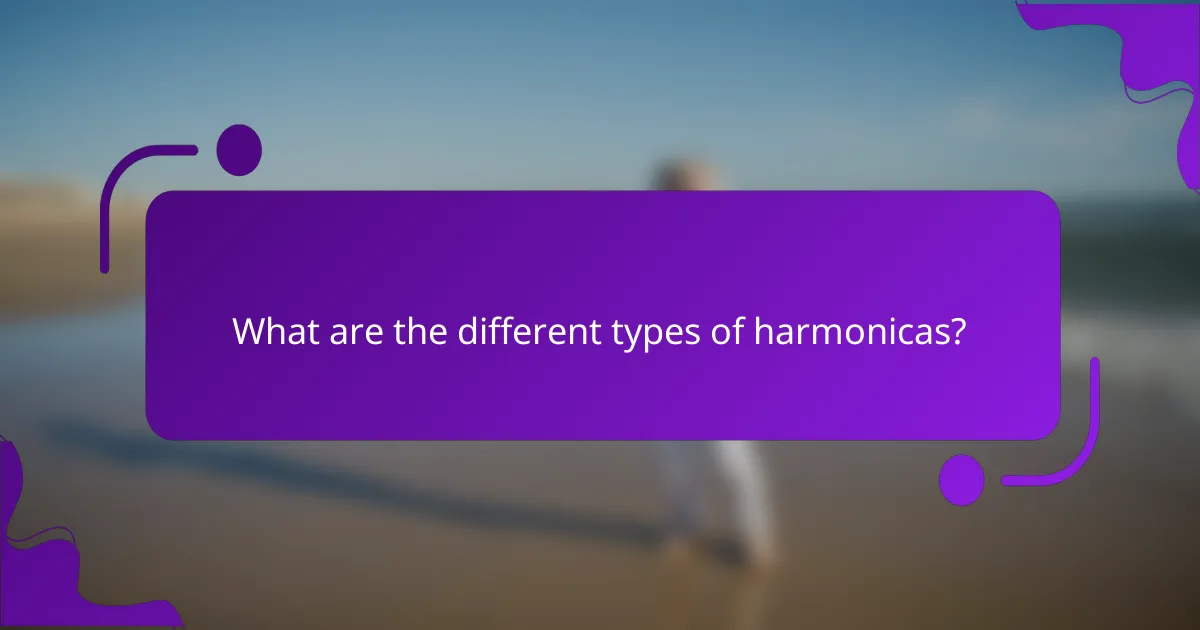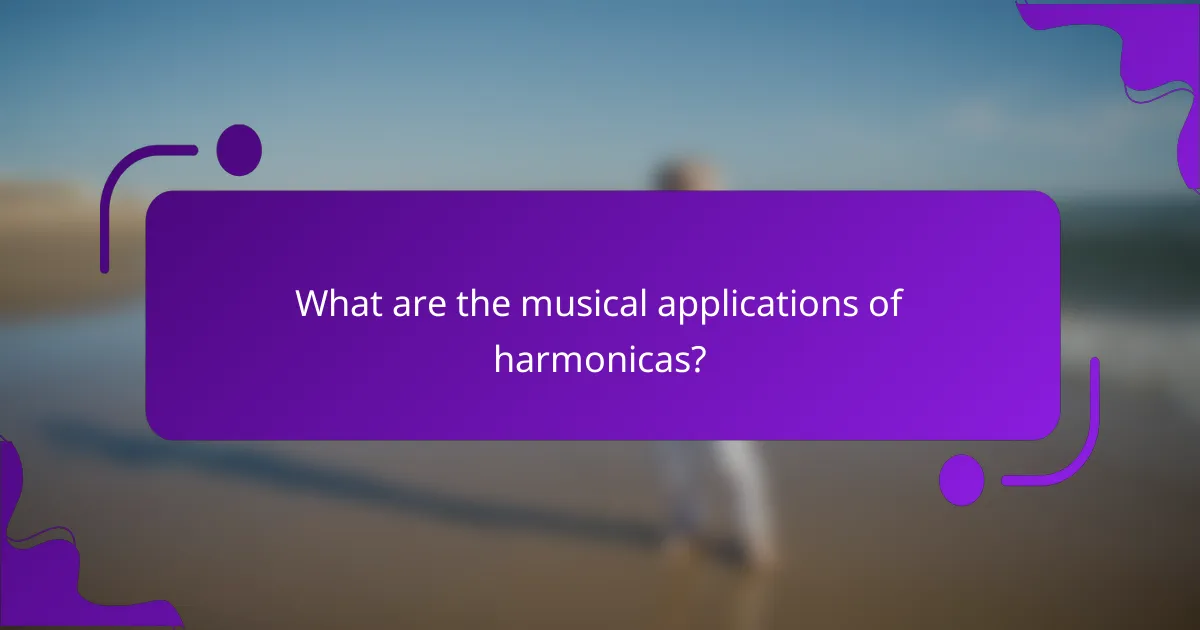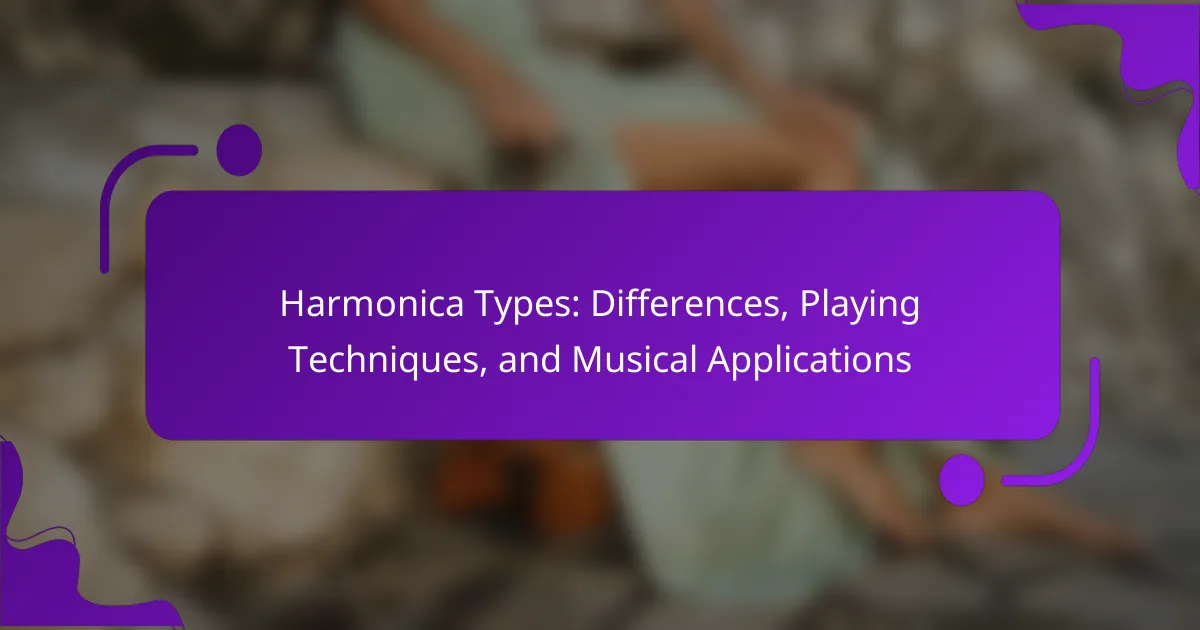Harmonicas are versatile musical instruments that come in various types, including diatonic, chromatic, tremolo, octave, orchestral, and bass harmonicas. Each type serves distinct musical purposes, with diatonic harmonicas being popular in blues and folk music, while chromatic harmonicas offer broader tonal access across genres. The article explores common playing techniques such as bending, tongue blocking, and overblowing, which enhance the expressiveness and range of harmonica music. Additionally, it highlights the harmonica’s applications in blues, folk, country, rock, pop, jazz, and classical music, showcasing its role in melody and accompaniment across diverse musical styles.

What are the different types of harmonicas?
The different types of harmonicas include diatonic, chromatic, tremolo, octave, orchestral, and bass harmonicas. Diatonic harmonicas are designed for playing in specific keys. They are commonly used in blues and folk music. Chromatic harmonicas feature a sliding bar that allows access to all notes. They are versatile and used in various musical genres. Tremolo harmonicas produce a wavering sound due to two reeds per note. They are popular in Asian music styles. Octave harmonicas play two reeds per note at different octaves. They create a fuller sound and are often used in folk music. Orchestral harmonicas are designed for ensemble playing with multiple harmonicas. Bass harmonicas produce low notes and support melody lines. Each type has unique characteristics that cater to different musical applications.
How do diatonic harmonicas differ from chromatic harmonicas?
Diatonic harmonicas differ from chromatic harmonicas primarily in their design and musical capabilities. Diatonic harmonicas are tuned to a specific key and typically feature 10 holes. Each hole produces a different note when blown or drawn. This design makes them ideal for playing blues, folk, and rock music.
In contrast, chromatic harmonicas have a button-activated slide mechanism. This allows players to access all 12 notes of the chromatic scale. Chromatic harmonicas are often used in jazz and classical music due to their versatility.
Furthermore, diatonic harmonicas are generally simpler to play for beginners. They focus on a limited set of notes, making them easier to learn. Chromatic harmonicas require more skill due to their broader range and complex techniques.
The differences in construction also influence the sound. Diatonic harmonicas produce a more raw and expressive tone. Chromatic harmonicas offer a smoother and more polished sound.
These structural and functional distinctions define how each harmonica type is used in various musical genres.
What are the unique features of diatonic harmonicas?
Diatonic harmonicas are designed to play in a specific key and are primarily used in blues, folk, and rock music. They feature ten holes, each producing a different note when blown or drawn. The construction includes a comb, reed plates, and cover plates. Diatonic harmonicas utilize a unique tuning system, allowing for bending notes, which adds expressiveness. They typically have a limited range, focusing on the major scale of their designated key. These harmonicas are compact and portable, making them ideal for musicians on the go. The simplicity of their design contributes to their ease of use for beginners. Additionally, diatonic harmonicas are often more affordable than other types, making them accessible for aspiring players.
What are the unique features of chromatic harmonicas?
Chromatic harmonicas have several unique features that distinguish them from diatonic harmonicas. They include a button-activated slide mechanism that allows players to access all twelve notes of the chromatic scale. This feature enables musicians to play in any key without changing instruments. Chromatic harmonicas typically have a larger number of reeds, usually ranging from 12 to 16, which contributes to their extended range. The construction often includes a mouthpiece that is designed for comfort and ease of play. Additionally, chromatic harmonicas are generally tuned to equal temperament, allowing for greater versatility in musical styles. These characteristics make them suitable for various genres, including jazz, classical, and pop music.
What are the characteristics of other harmonica types?
Different harmonica types exhibit unique characteristics. Diatonic harmonicas are the most common and typically have 10 holes. They are designed for specific keys and are popular in blues and folk music. Chromatic harmonicas feature a slide mechanism that allows players to access all notes in a scale. This makes them versatile for jazz and classical music. Tremolo harmonicas produce a wavering sound due to two reeds per note, often used in traditional Asian music. Orchestral harmonicas have a wider range and are used in ensemble settings. Each type has distinct playing techniques suited to its design and musical application.
What defines a tremolo harmonica?
A tremolo harmonica is a type of harmonica that produces a distinctive wavering sound. This effect is achieved by using two reeds for each note, which are slightly detuned. The detuning creates a natural vibrato effect when the player blows or draws air through the instrument. Tremolo harmonicas are commonly used in folk and traditional music. They are typically designed with a double chamber for each note, enhancing the sound’s richness. This harmonica type is known for its expressive capabilities. It is favored for playing melodies that require a warm, singing tone. The tremolo effect can be particularly effective in creating emotional depth in musical performances.
What is a orchestral harmonica and how is it used?
An orchestral harmonica is a specialized type of harmonica designed for orchestral settings. It features a wider range and enhanced tonal qualities compared to standard harmonicas. This instrument is often used to add unique textures and melodies in orchestral compositions.
Orchestral harmonicas can play both melodic and harmonic roles. They are typically incorporated in classical music arrangements. Musicians utilize them to blend with strings, woodwinds, and brass sections. The harmonica’s distinct sound can enhance the overall orchestral experience.
These harmonicas are played using techniques similar to other harmonicas, such as bending notes and using vibrato. They can be played solo or in ensemble settings. The orchestral harmonica contributes to the richness of the musical piece.

What playing techniques are used for harmonicas?
Common playing techniques for harmonicas include bending, tongue blocking, and overblowing. Bending involves altering pitch by adjusting the airflow and mouth shape. This technique allows for expressive notes and is essential in blues music. Tongue blocking uses the tongue to isolate notes while playing multiple holes. It creates a unique sound and is often used in folk and country music. Overblowing is a more advanced technique that enables players to access additional notes. This technique expands the harmonica’s range and is crucial for advanced playing styles. Each technique adds distinct character and versatility to harmonica music.
How do you play a diatonic harmonica effectively?
To play a diatonic harmonica effectively, focus on proper breath control and technique. Begin by positioning the harmonica correctly in your mouth. Use your lips and tongue to isolate specific holes. Draw and blow air gently to produce clear notes. Practice bending notes for expressive playing. Familiarize yourself with scales and simple melodies. Regular practice enhances muscle memory and control. Listening to skilled players provides valuable insight into technique and style.
What are the basic techniques for beginners?
Breathing techniques are essential for beginners learning to play the harmonica. Proper inhalation and exhalation create clear notes. Beginners should practice breathing from the diaphragm for more control.
Another fundamental technique is tongue blocking. This method involves using the tongue to block certain holes while playing others. It allows for more complex sounds and effects.
Additionally, beginners should learn to bend notes. Bending alters the pitch and adds expressiveness to music. This technique requires practice to master but is vital for blues and jazz styles.
Lastly, beginners should familiarize themselves with basic scales. Scales provide a foundation for improvisation and melody creation. Mastering simple scales can enhance overall playing skills.
What advanced techniques can enhance performance?
Advanced techniques that can enhance harmonica performance include bending notes, overblowing, and tongue blocking. Bending notes allows players to achieve a wider range of pitches. This technique is crucial for expressive playing and is commonly used in blues and rock genres. Overblowing enables players to access additional notes that are not available through standard playing. This technique expands the harmonic possibilities and is often utilized in advanced playing styles. Tongue blocking is a method where the player uses their tongue to block certain holes while playing others. This technique facilitates playing multiple notes simultaneously and enhances the overall sound. Mastery of these techniques requires practice and can significantly elevate a player’s musical expression and versatility.
What are the playing techniques specific to chromatic harmonicas?
Chromatic harmonicas utilize specific playing techniques that distinguish them from diatonic harmonicas. One primary technique is the use of a slide button. This button allows players to access additional notes and play in different keys. Players can bend notes, but the chromatic harmonica offers a more consistent pitch due to its design.
Another technique is the use of tongue blocking. This involves using the tongue to block certain holes while playing others, creating chords and harmonies. Players also employ single-note playing for melodic lines, taking advantage of the harmonica’s layout.
Additionally, vibrato is a common technique used to add expression to notes. Players achieve this by varying their breath control while playing. The combination of these techniques allows for a wide range of musical styles and expressions, making the chromatic harmonica versatile in performance.
How does the slide mechanism influence playing style?
The slide mechanism allows for smooth transitions between notes, significantly influencing playing style. It enables players to create expressive bends and slides, enhancing musicality. This mechanism supports techniques such as glissando, which adds a fluid quality to performances. Players can achieve a wider range of pitches and tonal variations. The slide mechanism encourages improvisation and personal expression. It is particularly useful in genres like blues and jazz, where emotional nuance is essential. Overall, the slide mechanism shapes how musicians interpret and deliver their music.
What techniques are unique to chromatic harmonica players?
Chromatic harmonica players use techniques such as bending, overblowing, and tongue blocking. Bending allows players to lower the pitch of notes, enhancing expressiveness. Overblowing enables access to higher notes, expanding the instrument’s range. Tongue blocking involves using the tongue to isolate notes, creating a richer sound. These techniques are essential for achieving the unique tonal qualities associated with chromatic harmonica playing. Additionally, chromatic players often utilize vibrato and pitch modulation to add emotional depth to their performances. These techniques are distinct from those typically used on diatonic harmonicas, showcasing the chromatic harmonica’s versatility in various musical genres.

What are the musical applications of harmonicas?
Harmonicas are used in various musical applications across genres. They serve as a primary instrument in blues, folk, and country music. In blues, harmonicas provide expressive melodies and improvisation. Folk music utilizes harmonicas for their simple, portable sound. Country music features harmonicas to enhance storytelling in lyrics.
Additionally, harmonicas are often used in rock and pop music for catchy hooks. They can be featured in jazz for solos and accompaniment. In classical music, harmonicas add unique textures to compositions. Their versatility allows for both melodic and rhythmic roles in ensembles.
How are harmonicas used in different music genres?
Harmonicas are used in various music genres, each showcasing unique playing styles and techniques. In blues music, harmonicas often provide expressive melodies and improvisation, enhancing the genre’s emotional depth. Rock music features harmonicas in solos and riffs, adding a distinct sound to the instrumentation. Country music utilizes harmonicas to create a folk-like atmosphere, often complementing storytelling lyrics. Jazz incorporates harmonicas for intricate improvisation, blending with other instruments in complex arrangements. Folk music uses harmonicas to evoke a rustic feel, often accompanying acoustic guitars. Additionally, in pop music, harmonicas can add a catchy hook or bridge, appealing to mainstream audiences. The versatility of harmonicas allows them to adapt to these genres, making them a valuable instrument across musical styles.
What role does the harmonica play in blues music?
The harmonica serves as a key instrument in blues music. It adds a distinct sound that enhances the emotional depth of the genre. Blues harmonica players often utilize techniques like bending notes and overblowing to create expressive melodies. The instrument is portable, allowing musicians to perform in various settings. Historically, the harmonica gained prominence in the early 20th century, particularly in African American communities. Influential blues artists, such as Little Walter and Sonny Boy Williamson, popularized its use. Their innovative playing styles showcased the harmonica’s versatility. Overall, the harmonica is integral to the blues sound, contributing to its unique character and appeal.
How is the harmonica utilized in folk and country music?
The harmonica is utilized in folk and country music primarily as a melodic and rhythmic instrument. It adds a distinctive sound that complements vocals and other instruments. In folk music, harmonicas often provide a simple yet expressive melody line. They enhance storytelling through music by emphasizing emotional themes. In country music, harmonicas contribute to the genre’s signature sound, often used in solos and instrumental breaks. The instrument can mimic the human voice, adding depth to the performance. Notably, artists like Bob Dylan and Johnny Cash have popularized its use in these genres. The harmonica’s portability allows musicians to incorporate it easily in live performances.
What are some tips for incorporating harmonicas into performances?
Incorporating harmonicas into performances enhances musical diversity. Select harmonicas that match the genre for better integration. Use harmonicas to add solos or melodic lines during instrumental breaks. Experiment with different techniques, like bending notes, to create unique sounds. Collaborate with other musicians to explore harmonica’s versatility. Ensure clear amplification to project the harmonica’s sound effectively. Practice transitions between harmonica and other instruments to maintain flow. Lastly, engage the audience by showcasing harmonica skills during performances.
How can musicians effectively collaborate with harmonica players?
Musicians can effectively collaborate with harmonica players by understanding the instrument’s capabilities and styles. They should communicate openly about musical goals and preferences. Musicians should also be aware of the harmonica’s range and tonal qualities. This knowledge allows for better arrangement of parts. Practicing together fosters synergy and enhances performance. Utilizing improvisation can create dynamic interactions. Listening to recordings featuring harmonica can provide insights into effective collaboration techniques. Engaging in jam sessions helps develop a natural flow between instruments.
What common mistakes should be avoided when playing harmonicas in a band setting?
Common mistakes to avoid when playing harmonicas in a band setting include playing out of tune. This can disrupt the overall harmony of the group. Another mistake is not listening to other musicians. Ignoring the dynamics of the band can lead to overpowering or being overpowered. Additionally, failing to stay in rhythm is a frequent error. This can cause disjointed performances. Playing too loudly is also a common issue. It can drown out other instruments and vocals. Lastly, neglecting to practice specific songs with the band leads to poor cohesion. Preparation is key for a successful performance.
The main entity of this article is the harmonica, a versatile musical instrument with various types and applications. The article provides an overview of different harmonica types, including diatonic, chromatic, tremolo, octave, orchestral, and bass harmonicas, highlighting their unique features and playing techniques. It also explores the distinctions between diatonic and chromatic harmonicas, the characteristics of other harmonica types, and the specific techniques used for effective playing. Additionally, the article discusses the musical applications of harmonicas across genres such as blues, folk, country, and jazz, along with tips for incorporating them into performances and collaborating with other musicians.
